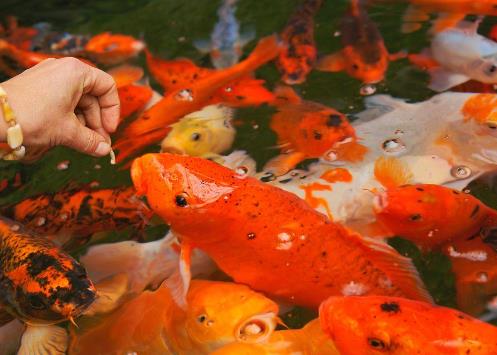The basic principles for feeding koi fish include feeding them at fixed times and in fixed amounts, choosing appropriate food, keeping the water clean, and adjusting the feeding frequency according to the seasons.

Feeding Frequency and Amount
The feeding frequency of koi fish should be adjusted according to seasonal changes:
- Spring (March to May): Feed them 2 to 3 times a day, and the amount of each feeding should be such that the koi fish can finish it within 5 minutes.
- Summer (June to August): Feed them 3 to 4 times a day, but reduce the amount of each feeding to avoid deterioration of the water quality.
- Autumn (September to November): Feed them twice a day to help the koi fish store energy for the winter.
- Winter (December to February of the following year): Feed them 1 to 2 times a week. The specific number of times depends on the water temperature and the activity of the koi fish.
Food Selection
Koi fish are omnivorous, and the selection of food should be diversified:
- Synthetic Feed: It is recommended to use a ratio of 60% plant-based bait and 40% animal-based bait.
- Natural Food: Plant fragments, bloodworms, earthworms, rice, bread crumbs, fruits, etc.
- Live Food: Such as mealworms, which have high nutritional value, but it is necessary to ensure that they are clean.
Feeding Skills and Precautions
- Feed Small Amounts at Multiple Times: Avoid overfeeding at one time, which may cause water pollution and put a burden on the stomachs of the koi fish.
- Observe the Color of Fish Feces: If the fish feces are green, brown or black, it indicates that the feeding amount is appropriate. If they are white, it means that too much food has been fed.
- Keep the Water Clean: Install a filter and replace one-tenth of the old water every day, especially in summer.
- Avoid Feeding on Cloudy, Rainy Days and in the Evening: During these periods, the air pressure is low and the dissolved oxygen in the water is low, which can easily lead to oxygen deficiency.
Feeding Strategies in Different Seasons
- Spring and Autumn: The water temperature is suitable, so feed them more times to ensure that the koi fish are well-fed.
- Summer: In the high-temperature season, reduce the amount of each feeding, increase the number of feedings, and pay attention to changes in water quality.
- Winter: The water temperature is low, so reduce the number of feedings to avoid water pollution caused by food residues.
Through scientific and reasonable feeding and management, the healthy growth of koi fish can be ensured, adding vitality and fun to the aquatic world.
